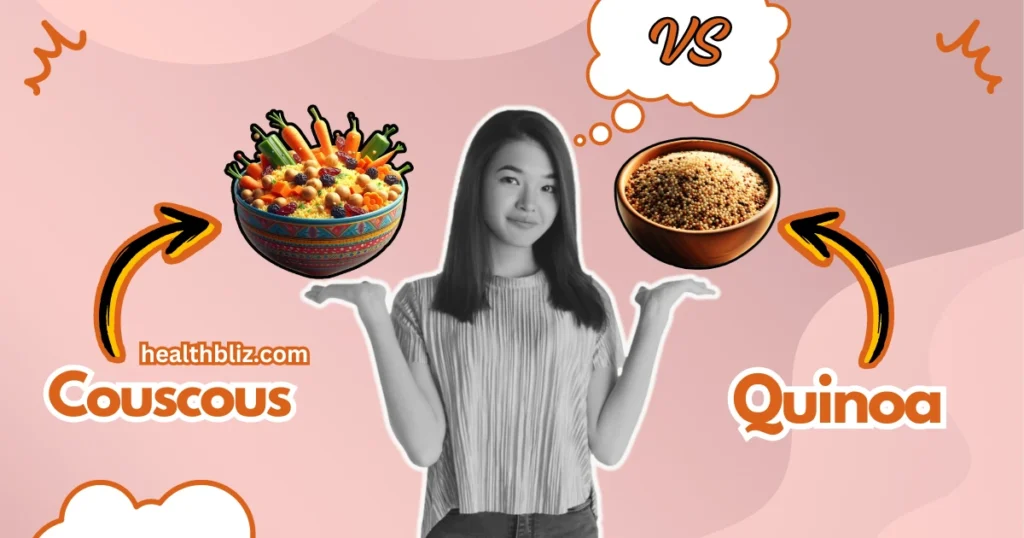
Small, grain-like foods like couscous and quinoa are frequently eaten in place of pasta and rice. Given their resemblance in appearance and culinary applications, many individuals tend to mix them up or simply question their differences. They have very different nutritional profiles.
This article aims to provide a comprehensive understanding of the key distinctions between quinoa and couscous, assisting you in making an informed decision on which one to select.
What are couscous and quinoa?
Despite their similar appearance, quinoa and couscous are different foods. A kind of tiny-beaded pasta called couscous is produced with steamed semolina, a durum wheat flour. It is therefore a staple food in Morocco, Algeria, and Tunisia in northern Africa and a member of the Gramineae, or grass, family. Conversely, quinoa is the seed of the quinoa plant, which is a member of the family Chenopodiaceae, also known as goosefoot. However, because of its nutritional makeup, it is categorized as a pseudo-cereal. In addition, it is usually eaten as a grain rather than a seed. The Andean region of South America is home to three distinct quinoa varieties: red, black, and white.
Nutritional comparison
Couscous and quinoa may have similar nutritional profiles, but their main distinctions lie in the quality of nutrients rather than the quantity.
Take a look at this comparison chart detailing according to usda the nutritional content of a 3.5-ounce (100-gram) serving of cooked couscous versus quinoa (1, 2) .
| Couscous | Quinoa | |
|---|---|---|
| Calories | 112 | 120 |
| Carbs | 23.2 grams | 21.3 grams |
| Fiber | 1.4 grams | 2.8 grams |
| Protein | 3.8 grams | 4.4 grams |
| Fat | 0.16 grams | 1.92 grams |
| Selenium | 50% of the Daily Value (DV) | 5% of the DV |
| Manganese | 3.6% of the DV | 27.4% of the DV |
| Folate | 3.7% of the DV | 10.5% of the DV |
| Iron | 2.1% of the DV | 8.2 % of the DV |
The main components of both foods are carbs, and they also contain a good amount of protein.
Impact on health
Couscous
Energy Source:
Couscous is a carbohydrate-rich food that provides quick energy for daily activities.
Moderate Nutritional Profile:
Couscous has a moderate nutritional profile, with some essential nutrients such as selenium, magnesium, and B vitamins. However, it is primarily a carbohydrate source, lacking the complete protein profile of quinoa.
Weight Management:
Moderate consumption of couscous in a balanced diet, combined with regular physical activity, can help maintain a healthy weight due to its high carbohydrate content.
Quinoa
Complete Protein Source
Quinoa stands out as a complete protein because it contains all nine essential amino acids required for human health. This makes it an excellent choice for people looking to meet their protein requirements, particularly those who follow a vegetarian or vegan diet.
Nutrient Density
Quinoa is high in fiber, vitamins (particularly B vitamins), minerals (including iron, magnesium, and phosphorus), and antioxidants. Its nutrient density improves overall health and well-being by supporting various bodily functions and promoting vitality.
Heart Health
Quinoa’s fiber and antioxidants may help lower cholesterol and reduce the risk of heart disease, making it a heart-healthy addition to the diet.
Blood Sugar Regulation
Quinoa has a lower glycemic index than many other grains, so it does not cause sharp spikes in blood sugar levels after consumption. This can be useful for people who have diabetes or want to control their blood sugar levels.
Digestive Health
Quinoa contains fiber, which promotes regular bowel movements and prevents constipation. Furthermore, fiber feeds beneficial gut bacteria, which promotes a healthy gut microbiome.
Difference between couscous and quinoa
Origin
- Couscous, a traditional North African dish made from semolina wheat, is a staple in Morocco, Algeria, and Tunisia.
- Quinoa is a pseudo-cereal crop native to South America’s Andes, particularly Peru and Bolivia, and is well-known for its high nutritional content.
Composition
- Couscous is made from semolina wheat, which contains gluten and is primarily composed of carbohydrates.
- Quinoa is gluten-free and botanically similar to spinach and amaranth. It’s a complete protein source, with all nine essential amino acids, fiber, vitamins, and minerals.
Texture
- Couscous has a light and fluffy texture that comes from steaming during preparation.
- Quinoa grains have a slightly crunchy texture when cooked, which adds a nice mouthfeel to dishes.
Flavor Profile
- Couscous has a neutral flavor profile, making it versatile and appropriate for a variety of culinary applications.
- Quinoa has a nutty flavor profile that improves the taste of dishes and complements a variety of ingredients.
Culinary Uses
- Couscous: Couscous serves as a base for dishes such as salads, stews, and pilafs, and can be flavored with herbs, spices, and other ingredients.
- Quinoa: Quinoa can be used as a substitute for rice, couscous, or pasta in recipes, and is commonly found in salads, soups, stir-fries, and breakfast bowls.
Nutritional Content
- Couscous: While couscous provides carbohydrates and some nutrients like selenium, magnesium, and B vitamins, it lacks the complete protein profile of quinoa.
- Quinoa: Quinoa is rich in protein, fiber, vitamins, minerals, and antioxidants, making it a nutrient-dense food and a complete protein source.
Gluten Content
- Couscous contains gluten, so it is not suitable for people who are gluten intolerant or have celiac disease.
- Quinoa is gluten-free, making it a safe and nutritious choice for people with gluten-related dietary restrictions.
Taste and culinary uses
Couscous
Taste: Couscous has a mild, neutral flavor that blends well with other ingredients and seasonings. Its subtle flavor allows it to be used in both savory and sweet dishes without overpowering other flavors.
Culinary Uses: Couscous is a versatile base for salads, stews, pilafs, and sides. Its quick cooking time and ability to absorb flavors make it an excellent canvas for incorporating a variety of ingredients, including vegetables, meats, herbs, and spices. Couscous can be served as a dessert when sweetened and topped with fruits, nuts, and honey.
Quinoa
Taste: Quinoa has a nutty, earthy flavor that adds depth to dishes. While quinoa has a distinct flavor, it also absorbs flavors well, making it suitable for a variety of cuisines and flavor combinations.
Culinary Uses: Quinoa, like couscous, has a wide range of culinary uses. It makes a healthy base for salads, soups, stir-fries, breakfast bowls, and even baked goods like muffins and cookies. Quinoa’s texture and flavor make it a popular ingredient in grain bowls, where it can be mixed with a variety of vegetables, proteins, and sauces.
Which one is better?
Couscous and quinoa are both delicious, adaptable, and simple to prepare. They each come with various health advantages, such as supporting the immune system, enhancing heart health and blood sugar regulation, and guarding against specific types of cancer. If you want to boost the nutritional value of your dish, increase your protein intake, or go gluten-free, quinoa is the way to go. On the other hand, if you’re just looking to mix things up from your usual pasta or rice, couscous can add some diversity to your daily meals. Just keep in mind that couscous isn’t suitable for a gluten-free diet.
People Also Like To Read: chia seeds in hot coffee benefits
Frequently Asked Questions
Q1: Which is healthier couscous or quinoa?
A1: Quinoa exhibits more potent anti-inflammatory and antioxidant properties in comparison to couscous.
Q2: Does quinoa look like couscous?
A2: No, quinoa does not look like couscous. While both are grains, couscous consists of small, spherical granules, whereas quinoa grains are small, bead-like seeds.
The Bottom Line
Couscous and quinoa have distinct nutritional profiles, with quinoa being rich in plant-based protein, fiber, and antioxidants, and having a low GI. Despite their differences, both grains provide various health benefits and can enhance the flavor of salads. Quinoa, however, offers more versatility in cooking, being suitable for soups, porridges, and baked goods. It is important to take into account your dietary requirements when deciding between the two, as quinoa is a gluten-free option whereas couscous is not.
People Also Like To Read:


